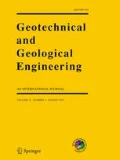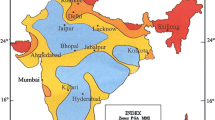Abstract
The seismically sensitive soft sediment deformations of Karewa Group have been geotechnically analysed to explore the status and frequency of past Quaternary earthquakes in Kashmir valley, India. The detailed studies were performed to establish the sequences of sedimentary structures in general and deformed structures in particular in view of geotechnical parameters. For the purpose the collected sediments from different deformed zones were analysed as per American Standard of Testing Materials for determination of size gradations, liquid limit, plastic limit and flow indices. The studied sequences of deformations were established in space and time by using empirically relationship. The structural architectures of sedimentary features (cross-beddings, massive beddings/loads) reveal the fluvial environments of fluctuating energy conditions for formation of sediment successions. In addition, the sandwiched-zonations of some peculiar structures preserved in the litho-succession may be formed through mechanism different from sedimentations. The size distribution of sediments from sandwiched-zone exhibits medium to fine sands and silt with sorting coefficients ranging from 1.21 to 2.54, coefficient of uniformity ranging from 1.26 to 3.6 with some exceptional values like 5.0, 16.6 and coefficient of curvature ranging from 0.67 to 1.80. The sediments of the same zone show the values of liquidity index ranging from 0.16 to 0.88 and plasticity index ranging from 3.69 to 18.57 with low blows values. These above size sensitive geotechnical parameter values show the higher flow indices and least resistance to flow. The sediments of the peculiar structural zone with characteristically higher flow indices and low resistance support the formation of the soft-sediment structures under seismic stress condition. The demarcated sandwiched zones with such conditions at the time frame of 1,06,566.6 years, 93,245.8 years and 54,502.8 years ago from recent appears to supports three prominent earthquake events (I, II and III) in the geological history of Quaternary deposits around Kashmir Valley, India.










Similar content being viewed by others
References
Agarwal KK, Agrawal GK (2005) A genetic model of thrust-bounded intermontane basin using scaled sandbox analogue models: an example from the Karewa basin, Kashmir Himalayas, India. Int J Earth Sci (Geol Rundsch) 94:47–52
Agarwal DP, Datta PS, Kusumgar S, Mehrotra NC, Nautihyal V, Pant RK, Shali SL (1981) Preliminary sedimentological studies on the Quaternary deposits of Kashmir, India. Aust Archaeol 12:103–105
Andrews CA, Martin GR (2000) Criteria for liquefaction of silty sedimentss. In: 12-WCEE proceedings
Arel E, Akin O, Mohsen (2012) Geotechnical properties of Adapazari silt. Bull Eng Geol Environ 71:709–720
Basavaiah N, Appel E, Lakshmi BV, Deenadayalan K, Satyanarayana KVV, Misra S, Juyal N, Malik MA (2010) Revised magnetostratigraphy and characteristics of the fluvio-lacustrine sedimentation of the Kashmir basin, India, during Pliocene-Pleistocene. J Geophys Res 115(B08105):17
Bhatt DK (1975) On the Quaternary geology of Kashmir valley with special reference to stratigraphy and sedimentation. Misc Pub GSI 24:188–203
Bhatt DK (1976) Lithostratigraphic sub-division of the Hirpur Formation (Lower Karewa) a critical review and modification. Misc Pub GSI 13:284–291
Bilham R, Gaur VK, Molnar P (2001) Himalayan seismic hazard. Science 293:1442–1444
Boulanger RW, Idriss IM (2004) Evaluating the potential for liquefaction or cyclic failure of silts and clays, report no. Ucd/cgm: 04/01
Boulanger RW, Idriss IM (2005) Evaluating cyclic failure in silts and clays. In: Proceedings, geotechnical earthquake engineering satellite conference on performance based design in earthquake geotechnical engineering: concepts and research. Prepared by TC4 Committee of ICSMGE, Japanese Geotechnical Society, Tokyo, pp 78–86
Boulanger RW, Idriss IM, Mejia LH (1995) Investigation and evaluation of liquefaction related ground displacements at Moss Landing during the 1989 Loma Prieta Earthquake, Report No UCD/CGM-95/02
Bray JD, Sancio RB, Durgunoglu T, Onalp A, Youd TL, Stewart JP, Seed RB, Cetin OK, Bol E, Baturay MB, Christensen C, Karadayilar T (2004) Subsurface characterization at ground failure sites in Adapazari, Turkey. J Geotech Geoenviron Eng 130:673–685
Burbank DW, Johnson GD (1983) Intermontane basin development in the past 4 million years in the North-West Himalayas. Nature 298:432–436
Chakraborty C, Ghosh SK (2005) Pull-apart origin of the Satpura Gondwana basin, central India. J Earth Syst Sci 114:259–273
Collinson JD, Thompson DB (1982) Sedimentary structures. George Allen and Unwin, London, pp 194–212
Dar JA, Dubey RK (2013) Deformation and neotectonics o Sub-Himalaya of Kashmir valley, India: a remote sensing and GIS approach. Int J Earth Sci Eng 6(5):940–947
El May M, Kacem J, Dlala M (2009) Liquefaction susceptibility mapping using geotechnical laboratory tests. Int J Environ Sci Tech 6:299–308
Farooqi A, Desia RN (1974) Stratigraphy of Karewas of Kashmir, India. J Geol Soc India 15:299–305
Hussain A, Iqbal S, Nasir S (2004) Geological maps of the Garhi Habibullah and Nauseri area, District Muzaffarabad, AJK: Geological Survey of Pakistan, Preliminary Map Series VI(14): Sheet No. 43 F/7, 11, 1:50,000
Ishihara K (1993) Liquefaction and flow failure during earthquakes. Geotech 43:351–415
Kishida H (1970) Characteristics of liquefaction of level sandy ground during the Tokachioki earthquake. Sediments Found 2:103–111
Kocbay A, Taner O (2006) Geotechnical properties and the liquefaction potential of the sediments around Efteni Lake (Düzce-Turkey) IAEG. Geol Soc Lond 773–818
Koester JP (1992) The influence of test procedure on correlation of Atterberg limits with liquefaction in fine-grained sediments. Geotech Test J 15:352–360
Kuenen PH, Menard HW (1952) Turbidity currents, graded and non-graded deposits. J Sed Pet 22:83–96
Maltman A (1994) Introduction and overview. In: The geological deformation of sediments, vol 1. Chapman and Hall, London, pp 94–125
Miura S, Kawamura S, Yagi K (1995) Liquefaction damage of sandy and volcanic grounds in the 1993 Hokkaido Nansel-Oki Earthquake. In: Proceedings of the 3rd international conference on recent advances in geotechnical earthquake engineering soil dynamics, vol 1, St Louis, Missouri, pp 193–196
Moretti M, Alfaro P, Canas JA (1999) Modelling seismites with a digital shaking table. Tectonophy 304:369–383
Obermeier SF (1998) Liquefaction evidence for strong earthquakes of Holocene and latest Pleistocene ages in the states of Indiana and Illinois, USA. Eng Geol 50:227–254
Obermeir SF (1996) Use of liquefaction-induced features for paleoseismic analysis-An overview of how liquefaction features can be distinguished from other features and how their distribution and properties of source sediments can be used to infer the location and strength of Holocene Paleo-earthquake. Eng Geol 44:1–76
Onweremadu EU, Ehumadu C, Elemike CS (2011) Geotechnical properties of soils as influenced by land use in a humid environment, Iranica. J Energy Environ 2:122–127
Perlea VG, Koester JP, Prakash S (1999) How liquefiable are cohesive sediments? In: Proceedings of second international conference on earthquake geotech engineering, vol 2, Lisbon, Portugal, pp 611–618
Ranjan G, Rao ASR (2010) Basic and applied soil mechanics, 2nd edn. New Age International Private Limited, Publishers, New Delhi, pp 30–120
Rezaei M, Ajalloeian R, Ghafoori M (2012) Geotechnical properties of problematic sediments emphasis on collapsible cases. Int J Geosci 3:105–110
Seeber L, Armbruster JG (1981) Some elements of continental subduction along the Himalayan Front. Tectonophysics 105:263–278
Seed HB (1979) Sediments liquefaction and cyclic mobility evaluation for level ground during earthquakes. J Geotech Eng Am Soc Civil Eng 105:201–255
Seed HB, Idriss IM, Arango I (1983) Evaluation of liquefaction potential using field performance data. J Geotech Eng 109:458–482
Seilacher A (1969) Fault-graded bed interpreted on seismites. Sedimentology 13:155–159
Sims JD (1975) Determining earthquake recurrence intervals from deformational structures in young lacustrine sediments. Tectonophy 29:141–152
Singh IB (1982) Sedimentation pattern in the Karewa basin, Kashmir valley, India and its geological significance. Pal Soc India 27:71
Singh S, Jain AK (2007) Liquefaction and fluidization of lacustrine deposits from Lahaul-Spiti and Ladakh Himalaya: geological evidences of palaeoseismicity along active fault zone. J Sed Geol 196(3):47–57
Suhail AK, Saleem RA, Bashar MA (2013) Analysing some geotechnical properties of soils to predict the swelling potential in the left side of Mosul city using GIS methods. Int J Chem Environ Biol Sci 1:52–56
Tasgin CK, Turkmen I (2009) Analysis of soft-sediment deformation structures in Neogene fluvio-lacustrine deposits of Çaybaoy Formation, Eastern Turkey. Sed Geol 218:16–30
Tohno I, Yasuda S (1981) Liquefaction of the ground during the 1978 Miyagiken-Oki earthquake. Soils Found 21:18–34
Valdiya KS (1999) Fast uplift and geomorphic development of the Western Himalaya in Quaternary Period. Memoir Gond Res Gr 6:179–187
Van Loon AJ (2009) Soft-sediment deformation structures in siliciclastic sediments: an overview. Geologos 15:3–55
Visher GS, Cunningham RD (1981) Convolute laminations—a theoretical analysis: example of Pennsylvanian sandstone. Sed Geol 28:175–189
Wadia DN (1976) Geology of India, 4th edn. Macmillan and Co Ltd, New York, pp 178–180
Wang WS (1979) Some findings in sediments liquefaction. Water Conservancy and Hydroelectric Power Scientific Research Institute, Beijing, pp 1–17
Acknowledgments
The authors thankfully acknowledge the financial assistance provided by University Grants Commission under the CSIR-UGC (NET-JRF) and Research Project Scheme (F.No.41-1038/2012SR,). Further, the first author is gratefully acknowledge the financial assistance provided by Department of Atomic Energy, Government of India in form of research projects (2013/36/56-BRNS/2447). The authors are thankful to Prof.D.C.Panigrahi, Director, Indian School of Mines, Dhanbad-826 004, India for his inspirations and supports.
Author information
Authors and Affiliations
Corresponding author
Rights and permissions
About this article
Cite this article
Dubey, R.K., Dar, J.A. Geotechnical Susceptibility Constraints on Seismicity of Karewa Group and Its Implication in Quaternary Earthquakes Around Kashmir Valley, India. Geotech Geol Eng 33, 609–620 (2015). https://doi.org/10.1007/s10706-015-9844-1
Received:
Accepted:
Published:
Issue Date:
DOI: https://doi.org/10.1007/s10706-015-9844-1



